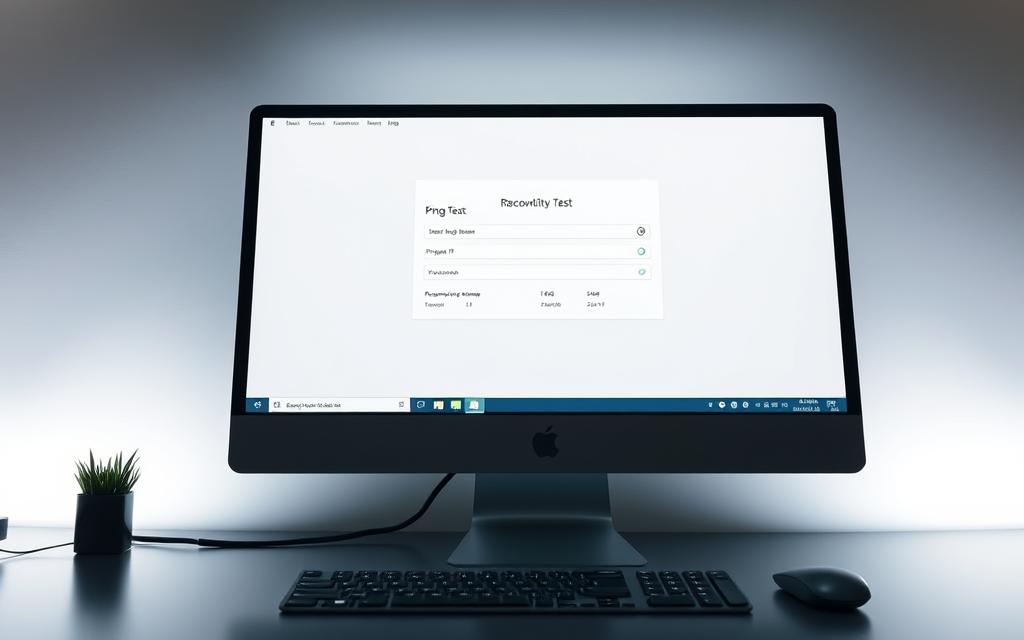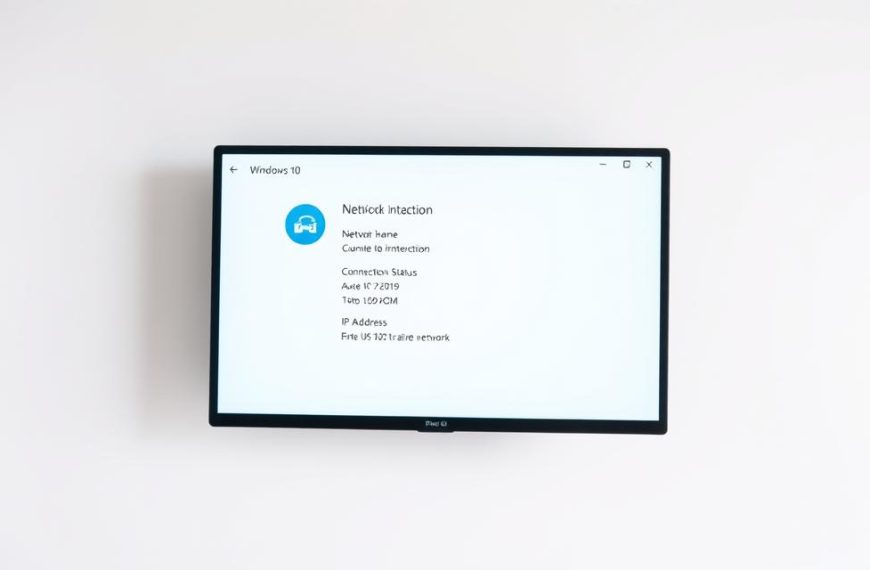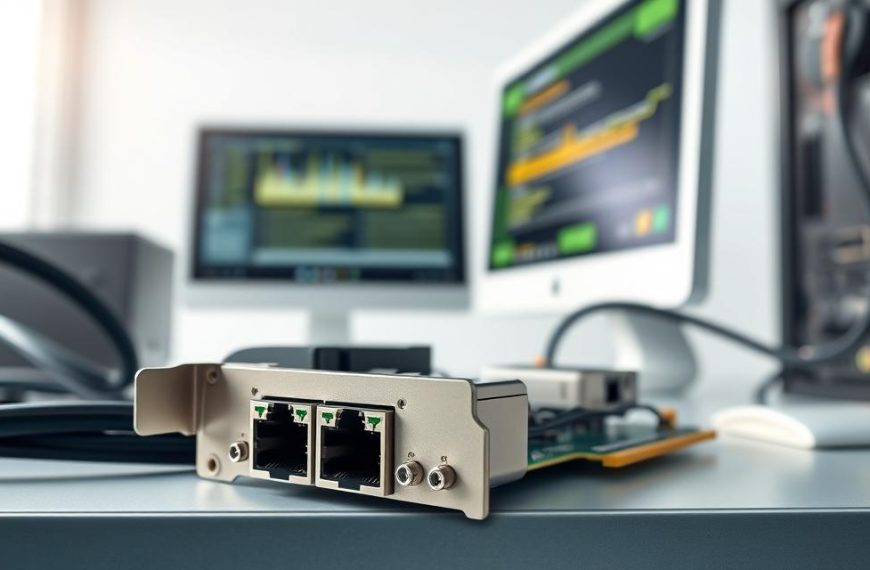When devices on your local network have connection problems, a network connectivity test is key. The ping command is a basic tool for checking network health. It’s used by both network experts and home users.
The ping command uses the ICMP protocol. It sends echo requests to another device and measures how long it takes to get a response. This tells you if a computer is online and how fast data moves between devices.
Learning about these basics can give you important insights into your network’s condition. For more on how to understand ping test results, check out our detailed guide on ping tests and their analysis.
Knowing how to use this simple tool helps you spot network issues fast. It’s a key step in solving more complex network problems.
Understanding Network Ping Tests and Their Purpose
Network ping tests are key tools for checking if devices can talk to each other. They help us see if connections are working right. This is important for keeping networks running smoothly.
What the Ping Command Actually Does
The ping command uses Internet Control Message Protocol (ICMP) to send messages. When you ping a device, your computer sends a small packet to its IP address. The device then sends back a reply, showing it got the message.
This back-and-forth shows us how well the network is working. It tells us about response times, how many packets get through, and if connections stay steady. Each reply gives us useful info about the network path.
ICMP packets follow the same paths as regular data. This makes ping tests a true reflection of network performance. The simple nature of ICMP means it works with almost all devices.
Practical Applications for Pinging Devices
Pinging devices is useful in many ways. It’s great for checking if a friend’s computer is online. This can save a lot of time when you’re planning to share files or play games together.
Network admins use ping tests to see if devices are working. The ping command in network troubleshooting is a first step for many IT pros. Home users can also use it to fix connectivity issues.
Doing ping tests regularly helps set a baseline for network performance. Knowing what’s normal makes it easier to spot problems. This helps avoid big issues before they start.
How Ping Results Help Diagnose Connectivity Problems
Ping results show us if there are network problems. A successful ping with quick response times means everything is working well. But, different problems show up in different ways.
Latency measurement through ping tests shows if the network is slow or far away. High response times can mean the network is busy or far. If ping times keep getting longer, the network might be getting worse.
Packet loss in ping results means there might be hardware issues or interference. Wireless networks often lose packets because of weak signals. Wired networks might have packet loss due to bad cables or equipment.
Request timeouts usually mean there’s a firewall blocking or the device is offline. This needs more checking into security settings and device status. Knowing how to read ping results makes it a powerful tool for fixing network problems.
To understand ping results, you need to know what’s normal for your network. Knowing the baseline helps spot problems. Any big changes from the baseline mean you need to look into it.
Essential Requirements Before Pinging Another Computer
Before you try to ping another device, make sure you have the basics right. This avoids problems and ensures your tests are reliable.
Network Setup and Configuration Needs
Both computers need to be on the same network to talk to each other. This is key for them to find each other using local addresses.
Know if you’re using a wired or wireless network. Also, make sure your routers and switches are working well. Faulty gear can cause issues.
Make sure network adapters have the right TCP/IP settings. Home networks usually use DHCP, while work places might use static IPs.
Access Rights and Permission Considerations
Most operating systems need admin rights to do network tests. Without these, pings might not work or give wrong info.
Firewalls can block ping requests. Many systems block ICMP by default. The computer you’re trying to ping must allow ICMP echo responses.
“Network diagnostics need the right setup and permissions. Missing either means your tests will fail.”
In work or school networks, extra rules might apply. Even with admin rights, policies could stop pings between devices.
Locating the Target Computer’s IP Address
To ping correctly, you need the target’s IP address. There are ways to find this, depending on the system.
On Windows, use ipconfig in Command Prompt. For macOS, go to System Preferences > Network. Linux users can use ifconfig or ip addr in terminal.
Network scanning tools can help find devices if direct access is hard. Tools like Advanced IP Scanner or Angry IP Scanner can show all devices on your network.
Dynamic IP addresses can change, like after a network restart. For reliable tests, set static IPs on devices you often ping.
How to Ping Friends Computer on My Network Using Windows
Windows systems have easy ways to check your network using the command line. First, you need to find the right tool and use the correct commands.
Accessing Command Prompt in Windows
There are several ways to open the command interface on Windows. The best method depends on your Windows version and what you prefer.
Multiple Methods to Open Command Prompt
You can start the command prompt in a few easy steps:
- Press Windows Key + R, type “cmd” and press Enter
- Search for “Command Prompt” in the Start menu search bar
- Navigate through Start Menu → Windows System → Command Prompt
Running as Administrator When Necessary
Some network tests need extra permissions. Right-click the Command Prompt icon and choose “Run as administrator” for more access.
Executing the Ping Command Properly
After opening the command line, use the right syntax for accurate tests.
Correct Syntax and Useful Parameters
The basic ping command is: ping [IP address or hostname]. For better tests, try these options:
- -t: Keep pinging until you stop it
- -n: Choose how many packets to send
- -l: Test with a specific packet size
Understanding and Analysing Response Times
Looking at response times gives you important network info. The round-trip time shows how long it takes for data to travel. If you see consistent timeouts, there might be a connection problem.
Watch for packet loss in your results. A high percentage means you might have network issues to fix.
Performing Ping Tests on macOS Systems
Apple’s macOS is great for checking your network. It uses the Terminal app for this. The ping command works the same as on other systems, but macOS has special features.
Accessing Terminal on Apple Computers
Finding Terminal on your Mac is easy. Go to the Applications folder and open Utilities. There, you’ll see Terminal and other tools.
To use Terminal often, add it to your Dock. Right-click the icon and choose “Keep in Dock”. Or, use Spotlight by pressing Command + Space and typing “Terminal”.
macOS-specific Ping Command Options
MacOS ping has special flags. The -c flag lets you set how many packets to send. The -i flag changes the packet interval.
For continuous pinging, use -a. It makes a beep for each reply. The -v flag gives detailed packet info.
“The macOS ping implementation offers granular control over network testing parameters, making it ideal for detailed diagnostics.”
Interpreting Results on Mac Systems
MacOS ping shows times in milliseconds. It also shows packet numbers and time-to-live. Good results mean stable connections.
Look for these signs in your results:
- Consistent response times under 100ms
- Zero packet loss percentage
- Stable round-trip time variations
- Proper hostname resolution
If results are bad, check your firewall. macOS’s firewall might block ICMP requests. Change these settings in System Preferences > Security & Privacy > Firewall.
For deeper checks, use Terminal with traceroute or netstat. This helps find if problems are local or with the network.
Using Linux Systems for Network Pinging
Linux systems have powerful tools for network checks, with ping being very useful. It works well on Ubuntu, Fedora, Debian, and more. The terminal lets you test your network in detail, showing how well it’s working and helping fix problems.
Opening Terminal in Various Linux Distributions
Starting the terminal is a bit different in each Linux version. Most modern ones offer several ways to open the terminal:
- Ubuntu: Press Ctrl+Alt+T or search for “Terminal” in the applications menu
- Fedora: Use the Activities overview and type “Terminal”
- Debian: Access through the system menu or use Ctrl+Alt+T shortcut
- Arch Linux: Typically uses a terminal emulator like Konsole or xterm
Once you open the terminal, you can use the ping command and other tools. This works no matter your desktop or distribution.
Linux Ping Command Variations and Flags
The Linux ping command has special options for more control over your tests. Unlike Windows and macOS, Linux ping runs forever until you stop it with Ctrl+C. This gives you ongoing data on latency.
Some important flags and variations are:
- -c count: Specify the number of packets to send
- -i interval: Set time between packets in seconds
- -s packetsize: Define custom packet size for testing
- -W timeout: Set wait time for response in seconds
- -q: Quiet output showing only summary statistics
These options let you tailor your tests to find specific network problems or slow spots.
Reading and Understanding Linux Ping Output
Linux ping output gives detailed stats that need to be understood. It shows each packet’s response and a summary when it ends.
Important parts of the output are:
- ICMP sequence numbers showing packet order
- Time-to-live (TTL) values indicating hop count
- Response times in milliseconds for latency measurement
- Packet loss percentage in the final summary
- Round-trip time statistics (min/avg/max/mdev)
Knowing these metrics helps fix network issues. High latency or packet loss means problems. Consistent TTL changes might show routing issues. The summary gives a quick health check of your network, helping you make changes.
Linux logs ping activities differently, which is useful for tracking network performance over time. This helps spot ongoing connection issues.
Troubleshooting Common Ping Problems and Errors
Ping tests can sometimes show unexpected results, even with the right network setup. Knowing how to deal with these issues is key to solving network problems. This part covers the most common ping problems you might face when checking if devices can talk to each other.
Resolving Ping Timeout Issues
Ping timeout errors happen when your computer sends out ICMP requests but gets no reply. This usually means there’s a problem with the connection to the target computer.
Start by checking the physical connections. For wired networks, look for any damage on Ethernet cables. Make sure they’re properly plugged into both devices and routers. Wireless connections might face signal problems or be too far away.
Router settings can also cause timeouts. Check if both devices show up in your router’s list of connected devices. Sometimes, just restarting your router and computers can fix temporary network issues.
Addressing “Destination Host Unreachable” Messages
This error means your computer can’t find a way to reach the target device. It usually points to setup problems, not physical connection issues.
First, make sure you’re using the right IP address for your friend’s computer. IP addresses can change if devices get them automatically. Also, check if both computers are on the same network subnet. Devices on different subnets can’t talk to each other.
Wrong gateway settings often cause this error. Make sure both devices use the same default gateway address, which is usually your router’s IP. This gateway helps devices on the same network talk to each other.
Firewall Configurations and Security Considerations
Firewall settings on either computer can block ping requests. Windows Firewall and other security software often block ICMP traffic for safety.
To let pinging through Windows Firewall:
- Open Windows Defender Firewall with Advanced Security
- Select Inbound Rules
- Find and enable “File and Printer Sharing (Echo Request – ICMPv4-In)”
Remember to turn these firewall settings back on after you’re done with your network checks. Leaving ICMP ports open all the time is a security risk. Always find a balance between keeping your network connected and keeping it safe.
Network Type Differences: Wired vs Wireless
The type of network connection affects ping results. Wired Ethernet connections usually offer more stable and quicker responses than wireless ones.
Wireless networks face challenges like signal strength, interference, and distance from the router. These can lead to ping results that vary and sometimes lose packets.
When doing network checks, remember your connection type. For precise tests, use wired connections to avoid wireless issues. Here’s a table showing typical performance differences:
| Connection Type | Average Ping Time | Stability | Packet Loss |
|---|---|---|---|
| Wired Ethernet | 1-2ms | Excellent | |
| Wireless 5GHz | 2-5ms | Good | 1-3% |
| Wireless 2.4GHz | 5-10ms | Fair | 3-8% |
Knowing these differences helps set realistic expectations when fixing network problems. Wireless connections often have higher latency and occasional timeouts, even if there’s no real network issue.
For consistent results in network diagnostics, test under similar conditions each time. Note whether you’re using wired or wireless connections. This context explains many variations in ping performance.
Conclusion
Using the ping command is key for checking network connections. It shows if devices can talk to each other on your network. You can use it on Windows, macOS, or Linux with simple commands.
When you look at ping results, you can spot problems like slow connections or lost packets. A successful ping means your network is reachable. But, if it fails, you need to dig deeper. Issues like timeouts or hosts that can’t be found might be due to IP problems, firewalls, or faulty hardware.
Starting to fix network issues with a ping test is a good idea. It’s the first step to finding bigger problems. For more complex issues, tools like traceroute or network analysers might be needed. Using ping regularly helps keep your network running smoothly.


















